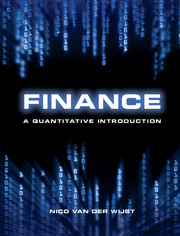Book contents
- Frontmatter
- Contents
- List of Figures
- List of Tables
- Acronyms
- Preface
- 1 Introduction
- 2 Fundamental concepts and techniques
- 3 Modern portfolio theory
- 4 Market efficiency
- Chapter 5 Capital structure and dividends
- 6 Valuing levered projects
- 7 Option pricing in discrete time
- 8 Option pricing in continuous time
- 9 Real options analysis
- 10 Selected option applications
- 11 Hedging
- 12 Agency problems and governance
- Solutions to exercises
- Glossary
- References
- Index
7 - Option pricing in discrete time
Published online by Cambridge University Press: 05 February 2013
- Frontmatter
- Contents
- List of Figures
- List of Tables
- Acronyms
- Preface
- 1 Introduction
- 2 Fundamental concepts and techniques
- 3 Modern portfolio theory
- 4 Market efficiency
- Chapter 5 Capital structure and dividends
- 6 Valuing levered projects
- 7 Option pricing in discrete time
- 8 Option pricing in continuous time
- 9 Real options analysis
- 10 Selected option applications
- 11 Hedging
- 12 Agency problems and governance
- Solutions to exercises
- Glossary
- References
- Index
Summary
Options are financial contracts that give their holders the right, but not the obligation, to buy or sell something on a future date at a price determined today. The distinction between right and obligation, which gives the holder a choice, is an essential characteristic. Options are derivative securities, they derive their values from the assets to be bought or sold in the future. The use of option-like contracts is very old. The oldest examples go back to Greek antiquity and in the 1600s options on rice were traded in Japan and options on tulips in the Netherlands. However, the world’s first options exchange did not open until 1973 in Chicago (Chicago Board of Options Exchange). In the same year Black and Scholes published their famous option-pricing formula. The trade in standardized options in Europe started in 1978 on the European Options Exchange in Amsterdam and has grown tremendously since then.
In this chapter we will model option prices in discrete time. After discussing the basic characteristics of options, we will lay the foundations of option pricing in state-preference theory. We then look at binomial option pricing with the wonderful Cox–Ross–Rubinstein model.
- Type
- Chapter
- Information
- FinanceA Quantitative Introduction, pp. 185 - 219Publisher: Cambridge University PressPrint publication year: 2013



